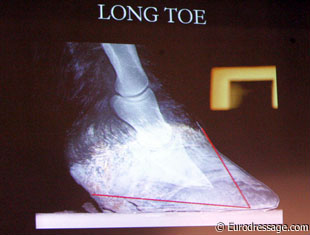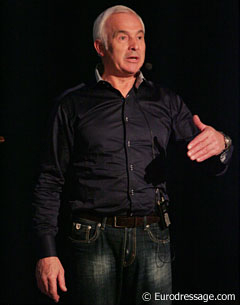
Day two of the Global Dressage Forum started out with a fantastic session on shoeing the dressage horse. Auditors were asked to make a choice between two sessions on Tuesday morning: Dutch team farrier Rob Renirie about correct shoeing or veterinarian Frits Sluyter about doping in the dressage sport.
As my colleague Barbara Schnell chose Sluyters' session, I was more than happy to sit in on Rob Renirie. Finding a qualified, knowledgeable farrier is a hard task and any horse owner can learn from a master such as Renirie. "So often I see problematic shoeing," Renirie admitted. "Too many farriers cut the heels or rasp the toes."
With his 35 years of experience Dutch team farrier Renirie was outspoken and very clear in his message. A good shoeing job corresponds with the anatomy of the horse. "The frog is important for the blood supply and to absorb shocks. You have to leave it as big as possible and leave the bars in. The sole is as thick on the toe as on the heel. You have to leave the toe as thick as possible," said Renirie.
"The coronet band determines the shape of the shoe." According to Renirie, a good horse shoe is wider at the heel for support, narrower on the sides for good traversal movements and a bit curbed at the toe so the hoof can roll on the footing of an arena instead of getting stuck in it.
 Renirie often takes X-rays of a horse's problematic feet to decide on the right shoeing. "You can see the pedal bones and determine the right position of the hoof," he said. Many horse owners ask their farrier to correct the position of the hooves by straightening the toe. " You can cripple a horse by trying to straighten a toe-in or a toe-out. The position of the joints can not be altered."
Renirie often takes X-rays of a horse's problematic feet to decide on the right shoeing. "You can see the pedal bones and determine the right position of the hoof," he said. Many horse owners ask their farrier to correct the position of the hooves by straightening the toe. " You can cripple a horse by trying to straighten a toe-in or a toe-out. The position of the joints can not be altered."
Renirie is a highly respected farrier and checks upon the Dutch dressage team horses. Adelinde Cornelissen's Parzival is one of the horses he "fixed". "Parzival had flat underrun heels and the wrong shoes. He is wide in front and narrow in the heel. We worked on him a few times and the horse had a tremendous recover in his feet." Eggbar shoes are good for horses who need more support due to tendon problems, though they interfere a bit with the mobility of the foot.
Trendy, hyped shoes like aluminium or magnesium ones are useless as they have bad traction and slip very easily. "Don't put on rock 'n roll shoes or pads," he said jokingly. Clips on shoes also interfere with the growing hoof. "They get too tight on the feet."
Renirie's messages were very simple and understandable. "Do not correct the feet, but protect the feet," he exclaimed. "A horse has to be comfortable. Shoe him on time, don't wait 8 to 12 weeks." His recommended time for a shoeing were 5 to 6 weeks in the summer and 7 to 8 weeks in the winter.
 "We keep our horses as prisoners in a stable, which is not good for the blood supply." With laminitic horses it is important not only to cool the legs, but also the feet. Feeding is also important for the health of the hooves. "Do not give too much feed because you'll give them too much sugar," he stated.
"We keep our horses as prisoners in a stable, which is not good for the blood supply." With laminitic horses it is important not only to cool the legs, but also the feet. Feeding is also important for the health of the hooves. "Do not give too much feed because you'll give them too much sugar," he stated.
The best way for a horse to go is barefoot! If your horses do not have problematic hooves or do not change surface too much, Renirie professes you should keep them barefoot. Rob, who said he became a farrier to solve a hoof problem with one of his own horses, admitted that he keeps his horses barefoot.
He took his auditors into Bartels' stables where he had found only one horse with a hoof problem. The horse had one narrow hoof and one wider hoof in front causing him to stand asymmetrically in the front legs. This problem could be fixed by adding a small wedge on the shoe of the wider feet to left the leg a few millimetres and get them in a symmetrical position.
Renirie was funny and passionate in his speech and he convinced the whole auditorium with his honest and truthful approach on horse hooves.
When Barbara Schnell returned from her session with Sluyter she reported that one of the main issues discussed was the installation of the 24/7 hotline to which owners can call about medication questions. Sluyter also demanded for more open communication between the riders/veterinarians and the FEI.
Text and photos copyrighted Astrid Appels/Eurodressage.com
No Reproduction allowed without explicit permission